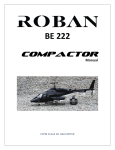Download user manual - Mobility Hire
Transcript
GB OPERATING MANUAL ELECTRONIC WHEELCHAIR, MODEL 9.506 AVANTAGE 2 / COMPACT 905 We move people. Contents Foreword ....................................................................................................... 7 Acceptance .................................................................................................... 8 Adjustment ................................................................................................... 8 Specifications................................................................................................ 8 Use ................................................................................................................. 8 Overview ....................................................................................................... 9 Model: 9.506 .........................................................................................................9 Driving ......................................................................................................... 10 Functional checks ...............................................................................................10 Brakes .......................................................................................................... 11 Service brake .......................................................................................................11 Braking the wheelchair ................................................................................11 Parking brake .....................................................................................................11 Selection lever ....................................................................................................12 Locking the brake .........................................................................................12 Releasing the brake ......................................................................................12 Drive-/push mode ...............................................................................................13 Selecting the push mode ..............................................................................13 Selecting the motor mode ...........................................................................13 Selecting the operation ............................................................................. 14 Pre-operation checks ..........................................................................................16 Charging procedure ......................................................................................17 Positioning the operating module....................................................................18 Function description .....................................................................................18 Horizontal adjustment..................................................................................18 Vertical adjustment .......................................................................................18 Remove the operating module....................................................................18 Fitting of the operating module..................................................................18 Turning the operating module to the side .................................................19 Arm supports .............................................................................................. 20 Adjusting the height of the arm supports ..................................................20 2 Remove the arm support..............................................................................21 Height stopper (Memory effect) ..................................................................21 Adapting the arm cushion to the seat depth .............................................21 Back support ............................................................................................... 22 Standard back support .................................................................................22 Standard back support cover .......................................................................22 Adjusting the back support height .............................................................23 Adjustable back .............................................................................................24 Adjusting the angle of the back support ....................................................25 ERGOpor-back support element ..................................................................27 Seat .............................................................................................................. 28 Adjusting the seat depth ..............................................................................28 ERGOpor seat element .................................................................................29 Seat angle ......................................................................................................30 Mechanically adjusting the seat angle ........................................................31 Electrically adjusting the seat angle ............................................................32 Adjusting the seat height .............................................................................33 Adjustment of seat width ............................................................................34 Adjusting the entry width ............................................................................34 Suspension of the chassis..............................................................................35 Leg supports ............................................................................................... 36 Calf strap ........................................................................................................36 Folding up the footplates ............................................................................37 Turning the leg supports to the side ..........................................................37 Remove the leg supports ..............................................................................38 Attaching the leg supports ..........................................................................38 Adjusting the height of the footplate ........................................................39 Angle adjustable footplates.........................................................................39 Continuous leg support .....................................................................................40 Folding up the foot board ...........................................................................40 Folding down the foot board ......................................................................40 Height adjustment of the footboard ..........................................................40 Angle adjustment of the footboard............................................................41 Depth adjustment of the footboard ...........................................................42 Height-adjustable leg supports .........................................................................43 Removing the height adjustable leg supports ...........................................43 3 Attaching the height adjustable leg supports............................................43 Adjusting the height of the footplate ........................................................43 Adjusting the height of the leg supports ...................................................44 Adjusting the depth of the calf pads ..........................................................45 Adjusting the height of the calf pads .........................................................45 Electrically height-adjustable leg support ........................................................46 Height adjustment ........................................................................................46 Adjusting the height of the footplate ........................................................46 Adjusting the depth of the calf pads ..........................................................46 Removing the electrically height adjustable leg supports ........................47 Attaching the electrically height adjustable leg supports.........................47 Stump support ....................................................................................................48 Removal .........................................................................................................48 Hanging-in .....................................................................................................48 Height adjustment ........................................................................................48 Angle adjustment .........................................................................................48 Repositioning the leg stump support..........................................................49 Repositioning the leg stump support..........................................................49 Repositioning the leg stump cushion ..........................................................49 Support wheels .......................................................................................... 50 Lap belt........................................................................................................ 51 Strapping on the lap belt with lock ............................................................52 Putting on the lap seatbelt with velcro fastener .......................................52 Adjustment of belt length ...........................................................................52 Torso supports ............................................................................................ 53 Adjusting the torso supports .......................................................................53 Head support .............................................................................................. 54 Adjustment of the head support .................................................................54 Attendant control with priority switch ................................................... 55 Positioning the controller.............................................................................55 Lighting ....................................................................................................... 56 Rear-view mirror......................................................................................... 56 Removing the rear-view mirror ...................................................................56 4 Attaching the rear-view mirror....................................................................56 Adjusting the rear-view mirror ....................................................................56 Specialities of the Junior version ............................................................. 57 Seat depth ...........................................................................................................57 Width adjustment of the leg support receptacles .....................................58 Continuous leg support .....................................................................................59 Folding up the foot board ...........................................................................59 Folding down the foot board ......................................................................59 Height-/ and angle adjustment of the footboard ......................................59 Depth adjustment of the footboard ...........................................................60 Adjusting the length of the leg supports ...................................................61 Arm supports ......................................................................................................62 Adjusting the height of the arm supports ..................................................62 Remove the arm support..............................................................................63 Inserting the arm support ............................................................................63 Clothes guard ................................................................................................63 Adjustment of seat width ............................................................................63 Loading and transportation ...................................................................... 64 Transport in vehicles...........................................................................................64 Transport security ...............................................................................................64 Passenger transportation acc. to ISO 7176/19 ..................................................65 Using the wheelchair as a passenger seat ..................................................65 Safety information ........................................................................................65 Product liability instructions.........................................................................65 Securing the wheelchair ...............................................................................66 Securing the user in the wheelchair ............................................................67 Service ......................................................................................................... 68 Maintenance .......................................................................................................68 Inspection ............................................................................................................68 Maintenance instructions .............................................................................69 List of annual maintenance work ................................................................71 Fault correction .............................................................................................72 Battery charger ...................................................................................................73 Wheel change .....................................................................................................74 5 Disassembly of the drive wheels ..................................................................74 Assembly of the drive wheels ......................................................................74 Disassembly of the steering wheels.............................................................75 Assembly of the steering wheels .................................................................75 Changing the tyres........................................................................................75 Fuses ....................................................................................................................76 Replacing the fuses .......................................................................................76 Lighting ...............................................................................................................77 Adjusting the headlights ..............................................................................77 Headlights......................................................................................................78 Front indicator...............................................................................................79 Rear indicator ................................................................................................80 Back light .......................................................................................................81 Information for the dealer ................................................................................82 Programming the driving behaviour...........................................................82 Driving parameter.........................................................................................83 Standard programming ................................................................................83 Standard settings ..........................................................................................83 Technical data ............................................................................................. 84 Kilometric performance .....................................................................................84 Hill climbing ability .......................................................................................84 Fuses ....................................................................................................................85 Lighting ...............................................................................................................85 Tools.....................................................................................................................86 Tightening torque for screwed connections ....................................................86 Model 9.506 / 9.506 -603....................................................................................87 Meaning of the labels on the wheelchair ........................................................91 Inspection certificate ..........................................................................................92 Guarantee ................................................................................................... 94 6 FOREWORD We thank you for the confidence you have placed in our company by choosing an electric wheelchair from this series. This manual is to help you get accustomed to the handling of the Electronic wheelchair as well as to prevent accidents. ☞ Note: Please note that the illustrated equipment variants can deviate from your model. The electric wheelchair can be adapted to your individual needs by way of the equipment variants and the accessories. Like any other vehicle, an electric wheelchair is a technical aid. It is subject to explanations, requires regular care and can cause danger when used improperly. The correct handling must therefore be learned. – Therefore chapters with options are also listed that might not be applicable to your vehicle. ! Attention: Read and observe the following documentation belonging to the electronic wheelchair before first use: – this operating manual, – the operating manual < operating module >. – the safety and general handling instructions < Electronic vehicles >. ☞ Note: Children should read the documentation belonging to the electronic wheelchair together with their parents respectively a supervisor or attendant before first use. 7 ACCEPTANCE SPECIFICATIONS All products are checked for faults in the factory and packed in special boxes. The electronic wheelchair is an environment-friendly electric vehicle. It was developed to extend the mobility of persons with health-related or agerelated restrictions. ☞ Note: However, we request that you check the vehicle for possible transport damage immediately on receipt – preferably in the presence of the carrier. ☞ Note: The packaging of the Electronic wheelchair should be stored for a further transport that might become necessary. ADJUSTMENT The specialist workshop will hand out the electronic wheelchair to you under consideration of all relevant safety instructions, ready for operation and adjusted to your needs. ☞ Note: The electrical adjustments are to be set for drive mode so that a safe operation of the vehicle is ensured. ☞ The tools required for adjustments and maintenance is listed under chapter < Technical Data >. 8 ☞ The model has been assigned the 'Use Class B' as per the EN12184 standard. USE The electronic wheelchair, with attached leg supports and arm supports, serves exclusively for the conveyance of one sitting person. Other pulling or transporting uses do not comply with its intended purpose. This model is an electric wheelchair especially for indoor and outdoor use on firm, level surfaces. OVERVIEW Model: 9.506 The overview shows the most important components and operating devices of the wheelchair. 1 2 Pos. Description 1 2 3 4 5 6 7 8 9 10 11 12 Back support Arm support Seat cushion (option) Leg support Calf strap Footrest Selection lever drive-/push mode Operating module Steering wheel Drive wheel Support castor Luggage rack with transport safety 13 Push bar 3 4 7 6 5 8 13 9 Drive mode Push mode 12 11 10 9 DRIVING Optimising the driving behaviour of the electronic wheelchair with the personal circumstances is to be co-ordinated by our service technician and your specialist dealer or therapist. The adaptability offers sufficient driving comfort as well as a high operating safety. You define the speed and direction yourself with the joystick movements (driving and steering lever) while driving as well as the pre-adjusted maximum final speed of your electronic wheelchair. 10 Functional checks The functions and safety of the electric wheelchair must be checked before the start of each journey. ☞ For this observe chapter < Inspections before starting to drive > in the Operating manual of the Operating module. BRAKES Service brake The motors work electrically as operating brake and carefully brake the electronic wheelchair down without jerks to stillstand. Braking the wheelchair For allotted braking of the wheelchair slowly guide the joystick back to the centre position (zero-setting). ☞ The wheelchair stops in shortest distance after releasing the joysticks. Parking brake The parking brakes only work when the selection lever is in the drive mode position. They disengage automatically when the wheelchair starts off. They are disengaged manually by moving the selection lever to the push mode position. ☞ Therefore observe chapter < Drive/ push mode >. 11 Selection lever Locking the brake 2 Swivel the selection lever forward as far as possible (1). ! Attention: It is impossible to push the electric wheelchair when in drive mode. • The brake performance reduces 1 with the brake pads are worn. If the electric wheelchair demonstrates an uneven or impaired braking effect, take it immediately to your specialist workshop for repair. Releasing the brake Activate the locking sleeve (2) on the selection lever and swivel the selection lever back as far as possible (3). ! Attention: Only transfer to and from the electric wheelchair when the wheelchair is switched off and the selection lever has been placed into the "drive" position! • Inadvertently knocking the joystick will set the electric wheelchair in motion without control! – Danger of accidents! 12 3 Drive-/push mode 1 The lever (1) for switching the drive motors between the drive mode and push mode is located on the right side of the wheelchair. ! Attention: Push the wheelchair only for manoeuvring or in emergency cases but never on gradients. 2 The electric magnetic brakes are switched off in the push mode. A braking of the wheelchair is then only possible by switching to the drive mode. Therefore do not switch to the push mode on gradients. Selecting the push mode 1. Switch off the operating module because the pushing will otherwise be made difficult by the electric system. 3 2. Pull the locking sleeve (2) up and then push the selection lever (1) the rear (3). ☞ The wheelchair can now be pushed. Selecting the motor mode 1. Push the selection lever to the front (1) until it audibly latches. 2. Switching the operating module on. The vehicle is now ready for driving again. 13 SELECTING THE OPERATION In order to obtain operational readiness of the electronic wheelchair the following directions are to be carried out in the indicated order. ☞ Note: 1 Charge the drive batteries via the operating module before the first journey. 1. Shift to drive mode Move the drive motors to the drive mode position. Push the selection lever to the front (1) until it audibly latches. 2. Check the tight seat of the battery fuse Blade-type fuse: The blade fuse (2) for the battery current has to sit tightly in the fuse holder. 14 2 3. Checking the position of the operating module The operating module should be positioned in such a way that you can comfortably and safely steer the electric wheelchair. 3 Horizontal adjustment: After loosening the clamping screw (3) the operating module can be adjusted horizontally. ! Attention: Tighten the again. adjusting screws 4 Vertical adjustment: ☞ Therefore observe chapter < Positioning the operating module >. 4. Switching the operating module on Press the ON/OFF-key on the key field of the control panel. ☞ Note: Only actuate the joystick (4) after the self-test of the electronics has been completed! ☞ Key-lock function: ☞ The key-lock function enables you to secure the wheelchair against unauthorised use. ☞ Observe user manual < Operating module >, chapter < Key function >. 15 Pre-operation checks Before starting to drive, the following should be checked: ☞ the battery charge level, ☞ the pre-selected top speed setting. – Therefore observe operation manual < Operating module >. ☞ Note: – Only transfer to and from the electric wheelchair when the wheelchair is switched off and the brake release lever has been placed into the forward position! Inadvertently knocking the joystick will set the electric wheelchair in motion without control! – Danger of accidents! 16 Charging procedure The charging process for sealed drive batteries takes longer than that for open batteries with liquid electrolyte due to physical reasons. 1 1. Switch the operating module off. The selection lever should be in the drive mode position. 2. Insert the battery charger plug into the operating module (1). ! Attention: Do not insert any objects other than the battery charger plug into the battery charging socket. – Danger of short circuit! 2 3. Switch on the battery charger, respectively, plug the mains plug of the battery charger into a convenient mains socket. The battery is now charging. The charging process only runs with an intact battery fuse (2)! A full charging of the drive batteries takes approximately 8 hours. 4. Disconnect the battery charger from the mains socket at the end of the charging process and then pull the charging plug out of the operating module. 17 Positioning the operating module Function description You will find a detailed description of the keys and symbols in the operating manual for < Operating module >. The position of the operating module can be adjusted to suit the individual size of the user. The control unit can also be detached for transportation or storage and can be laid on the seat or stored separately. ! Attention: Switch off the operating module before adjusting/removing it. 1 2 Remove the operating module To remove the control unit, slacken the clamping screw (1). Pull the operating module to the front. ☞ Carefully route the cable when doing this. Horizontal adjustment Fitting of the operating module Slacken the clamping screw for depth adjustment (1). Move the operating module into the desired position. In doing so carefully guide the cable and retighten the clamping screw securely. Insert the operating module into its clamping device. Tighten the clamping screw (1). Vertical adjustment With the optional height adjustable operating module adapter the operating module can be adjusted in height. Slacken the clamping lever (2) whilst holding the control unit, move the operating module into the desired position and then retighten the clamping lever. 18 ☞ Carefully route the cable when doing this. Turning the operating module to the side With the optional swivel away operating module adapter (1) the operating module can be swivelled back to the side (2) so that it is located parallel to the arm support. This makes it possible, for example: – to drive closer to a table, 1 – Remove the operating module more easily. For regular drive mode the operating module can be swivelled back toward the front (1) until it engages back into the magnetic lock. ☞ Note: ☞ The power of the magnets (3) can be reduced, for example with tape on top of the magnets, for easier swivelling of the operating module. 2 ☞ Should the operating module be positioned too close to the arm support, move it forward before swivelling. ! 3 3 Attention: Do not grab into the area of the cross brace. – Danger of squashing! 19 ARM SUPPORTS The arm supports can be adjusted in height to suit the needs of the user. ! • 1 Attention: Do not use the arm supports to lift or carry the wheelchair. Do not drive without the arm supports! Adjusting the height of the arm supports Slacken the clamping screw (1), slide the end stop fully up and lightly tighten the clamping screw (1). ! Attention: Before loosening the clamping screws (1) secure the arm support against falling down with your hand. – Danger of jamming with disassembled or too loosely screwed clamping screw (1)! • During the adjustment the maximum arm support height is reached when a mark (2) becomes visible above the receptacle tube. • Ensure the tight fit of the clamping screw (1) in order to prevent the arm support from sliding down. ☞ Note: Danger of jamming when adjusting the height of the arm supports if the cushions are in a deep setting! 20 2 Remove the arm support Slacken the clamping screw (3) and pull off the arm support upwards. 3 5 ☞ Note: The operating module must be removed first if the arm support on the control side is to be detached. To remove the control unit, slacken the clamping screw (4). ☞ Note: Carefully route the cable when doing this. Height stopper (Memory effect) The firm stopper (2) of the insert tube (5) serves as a height marker. 4 Adapting the arm cushion to the seat depth By displacing the arm supports the resting position can be adapted for example to a changed seat depth. ! Attention: Retrospective refitting should be carried out by a specialist workshop! – After removing the countersunk screws (6) the arm support can be displaced. 2 6 21 BACK SUPPORT Standard back support 1 The standard back support (1) is steplessly angle adjustable from about 0° to 30°. Standard back support cover The standard-back strap is spanned through the backrest tubes. The extended part of the back (2) is attached with velcro to the seat surface. Folding over the back support 2 Screw far out the clamping screw (3) at both sides. Pull up the back support and then fold it forwards (4). Folding up the back support After erecting press the back support fully downward. ! 5 Attention: Do not grab into the back tube bracket (6) with the fingers. – Danger of squashing! 3 ☞ Note: It is to be ensured that the contour of the bolt (5) grabs securely into the recess. Then fasten the clamping screws (3). 6 4 22 Adjusting height the back support The standard and adjustable back cover can be adjusted in height. For this unscrew the respective screws (1) of the cover and reinsert in the other height position. 1 23 Adjustable back (Option) The adjustable back is adjustable through a velcro strap, the so called spanning straps (2). The cushion (1) is placed over it and attached with the velcro strap. 2 1 Adjusting the adjustable back ☞ Note: ☞ The fitting of the adjustable back (2) is best carried out with the user sitting in the wheelchair and the seat angle is set at 0°. ☞ Adjustment is carried out from the bottom to the top. ☞ The lower part of the adjustable back should remain slightly loose so that it adapts to the buttocks when bending forward. Place the back cushion The back cushion (1) is to be folded over in the centre between the two horizontal seams 180° around the upper spanning straps (2). – This creates a soft upper edge. ☞ Note: When the user leans against the front cushion again, pay attention that: Attention: The overlapping of the Velcro fastener has to be at least 10 cm! ☞ The pressure of the back must be 1. Pull off the rear part of the cushion. ☞ A complete hand should fit in be- ! 2. Span the spanning straps tightly over the small of the back and lumbar spine in order to give maximum support. 3. Adjust the remaining straps to the form of the back. 4. Afterwards loosen the front part of the cushion and align it with the spanning straps. ☞ In doing so the user should lean forward. If necessary ask an aid to help out! 24 spread evenly throughout the back cover. tween the cover and back at the upper edge of the back cover. ☞ The head of the user must be held at balance by the back cover. Adjusting the angle of the back support 2 Mechanical back support adjustment 1 – Loosen clamping screw (3). – Loosen counter nut (2) and screw it back. 3 – Set the adjustment screw (1) according to the desired back support angle. – Tighten the counter nut (2) to secure the adjustment screw (1). – Tighten the clamping screw (3). ☞ Note: 4 For a level back support surface set the adjustment screws (1) on both sides evenly. Manual back angle adjustment with gas pressure spring (Option) The continuous angle adjustment of the back support is achieved through two pneumatic springs. ☞ Note: Before activating the release lever (4) hold on to the back support grip in order to prevent the back support from unintentionally snapping up. – Activate both release levers (4) simultaneously and adjust the back tubes parallel. – Let go of both release levers (4) simultaneously. – The back support is set again. 25 Electrical back support adjustment (Option) The back support (1) is electrically adjustable. ☞ Note: Herefore view the operating manual < Operating module >. ! 1 Attention: Only adjust the back support when the wheelchair is standing on a level surface. A danger of tipping over exists on gradients! Folding down the electrically adjustable back support To fold the electrically adjustable back support (2) down, first press the release button (3), then remove the pin (4). 2 ☞ Keep the back support in position with one hand at the pushing handle. Afterwards fold the back support down (2). ☞ Reinsert the pin (4) in order to prevent loss. Check the locking device after folding the back support up and reinserting the pin. ☞ Keep the pin clean at all times for flawless function. 26 4 3 ERGOpor-back support element (Option) Remove the ERGOpor-back support unit Loosen the attachment screws (1) and push the clamping tins inward. Then push the backrest element forwards out of the backrest frame (2) and remove it. 1 ☞ It is impossible to remove the back element with mounted side cushions. Attaching the ERGOpor back support element Press the back support element, left and right, onto the back support frame (3). 2 Push the securing screws (1) of the clamps outwards and then tighten them. ERGOpor back support cushion The ERGOpor back support cushion (4) is secured to the back support shell with Velcro fasteners and can be pulled off. 3 2 3 4 27 SEAT Adjusting the seat depth 1 The seat depth can be changed by moving the back support to a different position. ☞ Note: The adjustment must be carried out by a workshop. For this the attachment screws (1) are to be removed on both sides. Then attach the back support holders again at the desired position with the securing screws. ☞ Note: Hereto observe subchapter < repositioning the arm support cushion >. Afterwards reattach the seat flap to the seat plate/-cover (3). – Velcro fastener. 3 28 ERGOpor seat element (Option) ERGOpor seat cushion The ERGOpor seat cushion is secured to the seat shell with Velcro fasteners and can be pulled off. ERGOpor seat element For cleaning- or maintenance work the ERGOpor seat unit can be removed. ☞ Note: The adjustment must be carried out by a workshop. 1. Remove the seat cushion and the ERGOpor back support. ☞ Note: 1 Therefore observe subchapter < Removing the ERGOpor back support >. 2. Disassemble the four attachment screws (1) of the seat shell. Reassemble the components in the same position after cleaning and maintenance. Afterwards place the ERGOpor seat cushion back into the seat shell and fasten it. – Velcro fastener. 29 Seat angle The seat angle (1) can be adjusted through the telescopic rod in steps. ☞ See < Technical data >. Observe chapter < Adjusting the headlights >. ! Attention: Adjust the seat angle only when the wheelchair is standing on a level surface. A danger of tipping over exists on gradients! • The seat-angle adjustment is not linked with an automatic speed reduction function. • An increased danger of tipping over exists with a reclined back support. • Before starting to drive make sure that no negative seat angle has been adjusted, respectively that a safe seating position is ensured. 30 1 Mechanically adjusting the seat angle Before mechanically adjusting the seat angle lift the seat slightly. Screw the clamping screw (2) on both sides far outward. Lift or lower the seat up to the marker, according to the desired seat inclination. Reinsert the clamping screw on both sides and tighten. ! • 2 Attention: In doing so make sure that the point of the clamping screw presses into the respective indentation. Lift the seat maximum to the lowest mark (3). 3 ☞ Note: Further seat angles can be adjusted through the combination of the rear seat frame receptacles for the seat heights 45, 48 and 50 cm and the two screwing positions of the front telescopic rods. – Only have this adjustment carried out in a specialist workshop. 31 Electrically adjusting the seat angle (Option) The seat angle can be adjusted electrically. The adjustment is carried out with the adjustment module. ☞ Note: Herefore view the operating manual < Operating module >. ! Attention: Adjust the seat angle only when the wheelchair is standing on a level surface. A danger of tipping over exists on gradients! Rising aid The seat is angled forward for the stand-up aid (negative seat angle). ☞ The negative seat angle adjustment serves the stand-up aid while the vehicle is standing. ☞ The steering wheels must face towards the rear when tilting the seat surface forward. ! 32 Attention: Switch off the operating module and fold up the footplates. Adjusting the seat height The seat frame receptacle (1) enables setting of two further seat heights. 2 ☞ View < Technical data >. 1 For this the screws (2+3) are to be disassembled. ☞ The self securing nuts are to be replaced after several implementations. ! Attention: The seat height 45 cm is not permitted in combination with the electric seat angle due to a danger of jamming between the seat frame and chassis at the back of the vehicle! 3 33 Adjustment of seat width The seat width can be adjusted by a lateral displacement of the arm supports. Displace both arm supports by an equal distance after slackening the clamping screw (1) on both sides. ☞ Note: A reduction of the seat width to less than 43 cm is possible by switching the two arm supports. 1 Retrospective refitting should be carried out by a specialist workshop! ! Attention: The maximum seat width has been reached when a marking (2) is visible on the square tube. 2 Adjusting the entry width The footplate distance is adjustable by sliding the leg support bracket (3). Displace both leg support bracket by an equal distance after slackening the clamping screw (4) on both sides. ! 34 Attention: The maximum entry width is reached when a hole becomes visible. 3 4 Suspension of the chassis For optimal sitting comfort the suspension (1) can be adjusted according to the desire of the user. ! Attention: Make sure that the adjustment ring sits securely before starting to drive. 1 – Screw a loose adjustment ring tight enough, until the pressure of the spring prevents further loosening. 2 Adjusting the seat suspension For adjustment of the suspension the adjustment ring (2) is screwed forward or backward accordingly. In doing so the following indications are valid: Adjustment ring slightly screwed a – up to 80 kg ☞ Soft suspension/low user weight. Adjustment ring medium pre-attached b – up to 100 kg ☞ Medium suspension/ medium user weight. Adjustment ring extremely screwed c – up to 130 kg ☞ Hard suspension/high user weight. ! Attention: The adjustment of the suspension may only be done by a specialist workshop. – The spring might be under extreme pressure. • In Position "a" and "c" at least three screw threads must be visible! 35 LEG SUPPORTS ! Attention: Do not use the leg supports to lift or carry the wheelchair. • Lift the feet, respectively place them on the footplates before each movement of the wheelchair. • The operating module is to be switched off: – before placing the feet on the floor, – to remove the calf belt and the leg support, – before folding up the footplates. Calf strap The calf strap (1) prevents the feet from sliding off of the footplates. It is guided around special ligament (2) and adjusted in length with a velcro fastener. Removal of the calf belt is achieved by opening the velcro straps. ! 36 Attention: Do not drive without the calf belt. – The leg strap is omitted for height adjustable leg supports and is replaced by the leg padding. 1 2 Folding up the footplates The footplates are to be folded up for entering or exiting the wheelchair (1). Turning the leg supports to the side For easy transfer out of/into the wheelchair as well as driving closer to a closet, bed or bathtub the leg supports can be swivelled away toward the in-/outside (2) + (3). 1 Therefore pull or press the respective locking lever (4) and swivel the corresponding leg support inward/outward. ☞ Note: Before swivelling the leg support outward/inward loosen or remove the calf belt on one side. ! 2 Attention: Swivelled-away leg stump supports are automatically unlocked and can easily fall off. Note this when handling (e.g. transport). • When swivelling them back make sure that the leg support audibly locks into place. ☞ Note: 3 After swivelling the leg support inward again do not forget to check the corresponding locking device. Afterwards replace the calf strap. 4 37 Remove the leg supports For easy transfer into and out of the wheelchair as well as a reduced wheelchair length (important for transport) the leg support can be removed (1). ☞ Note: Before swivelling the leg support loosen or remove the calf belt on one side. 1 – Remove both feet from the footplates. – Pull or press the locking lever backward (2). – Swivel the leg support sideways and take them off toward the top (1). Attaching the leg supports With the leg support in a swivelledaside position, hang it in and then swivel it to the front until the locking device audibly latches. ☞ Note: After swivelling the leg support inward again do not forget to check the corresponding locking device. Afterwards replace the calf strap. 38 2 Adjusting the height of the footplate Loosen the clamping screw (1) to adjust the height. 1 Telescope the foot plate to the desired height and then retighten the screw. ☞ Note: 2 The maximum extension is indicated by a marking (6) on the tube (2). Angle adjustable footplates (Option) After loosening the clamping screw (5) pull out the dovetail connection and adjust the angle of the footplates. Afterwards retighten the clamping screw (5) ! 5 Attention: Ensure that the footplate has sufficient ground clearance. 6 39 Continuous leg support The footboard of the continuous leg support (1) can be folded up to the side. Folding up the foot board 1 For an unobstructed foot area, fold up the left side of the foot board to the right as far as it will go (2). Folding down the foot board Fold down the left side of the foot board until it rests on the foot board holder (3). Height adjustment of the footboard 2 Loosen the clamping screw (4) to adjust the height. Telescope the foot plate to the desired height and then retighten the screw. ☞ Note: The maximum extension is indicated by a marking (6) on the tube (5). 3 4 6 5 40 Angle adjustment of the footboard – Switch the wheelchair off and shift the brake release lever into the drive position. – This prevents the wheelchair from rolling away accidentally. 5 – Loosen the screwed connection (5) and adjust the footboard to the desired angle. Afterwards retighten the screwed connection (5). – In doing so the teeth of the angle adjustment must join again 41 Depth adjustment of the footboard The depth adjustment of the footboard is done by repositioning the removable distancer pieces (6). – Light the footboard slightly on the left side. 6 – Reposition the desired amount of distancer pieces on the left side. – Pull/press the distancers that are to be repositioned on the right side of the footboard outward from the retaining rod (7). 7 ☞ Note: In certain angle settings of the footboard it is possible that a removal or placing of certain distancer pieces is not possible. In this case loosen the clamping screws for the angle adjustment (5) and change the position of the footboard so that a removal or placing of the distancer pieces is possible. Afterwards retighten the clamping screws. – Repositioning the footboard. – Insert the distancer pieces as far as possible onto the right retaining rod again. – Swivel the footboard down and hang it into place. 42 5 Height-adjustable leg supports (Option) 2 Removing the height adjustable leg supports For this pull back or press the locking lever (1). 1 Afterwards swivel the leg support to the side and then pull it off in an upward direction. Attaching the height adjustable leg supports 2 With the leg support in a swivelledaside position, hang it in and then swivel it to the front until the locking device audibly latches. ☞ Note: After swivelling the leg support inward again do not forget to check the corresponding locking device. Adjusting the height of the footplate Disassemble the screw (2) to adjust the height of the foot plate. Telescope the foot plate to the desired height and then secure it with the clamping screw (2). 43 Adjusting the height of the leg supports When seated in the wheelchair, ask a carer to raise the leg support to the desired level. The length adjustment is given through the turning point at the height of the knee joint. 1. First secure the leg support with one hand against folding down, and then loosen the clamping lever (1). ! Attention: Do not let the leg support drop on its own weight. – Danger of squashing! 2. Have the leg support lifted to the desired level by an attendant and retighten the clamping lever (1). To lower the leg support, remove the load momentarily from the support by raising the lower thigh (ask an attendant if necessary), and loosen the clamping lever (1). The leg support can now be moved slowly downwards. ! 44 Attention: Never put the free hand into the adjustment mechanism while adjusting the height adjustable leg support. 1 Adjusting the depth of the calf pads The calf cushion (1) can be swivelled to the side and adjusted steplessly in depth. Loosen the screws (2) to adjust the depth of the calf cushion. 1 2 3 Adjusting the height of the calf pads Loosen the clamping screw (3) to adjust the height of the calf cushion. 45 Electrically height-adjustable leg support Electric contact is automatically established when attaching the electrically height adjustable leg support. ! 1 Attention: Do not reach into the adjustment mechanism. – Danger of crushing! Height adjustment For the height adjustment of the leg supports view the users manual < Operating module >. – Whilst sitting in the wheelchair, raise or lower the leg support fig. to the desired height via the operating module. ! Attention: Observe the safety and general handling instructions < Electronic vehicles >! 1 2 Adjusting the height of the footplate To adjust the height, hold on to the footplate and depending on version loosen or remove the attachment screw (1). Telescope the foot plate to the desired height and then secure it with the clamping screw (1). Adjusting the depth of the calf pads The calf cushion (2) can be swivelled to the side and adjusted steplessly in depth. Loosen the screws (3) to adjust the depth of the calf cushion. 46 3 Removing the electrically height adjustable leg supports 4 Depending on version, pull the locking device (4) back, press it in or fold it up or down. Afterwards swivel the leg support to the side and then pull it off in an upward direction. ! Attention: With the electrically adjustable leg support removed the electric contact (5) is to be protected from dampness, wetness as well as dust and dirt! – Function error of the electrical adjustment. 4 Attaching the electrically height adjustable leg supports With the leg support in a swivelledaside position, hang it in and then swivel it to the front until the locking device audibly locks into place. ☞ Note: ☞ After swivelling the leg support inward again do not forget to check the corresponding locking device. ☞ Conduct a function test of the electrical adjustment! 5 5 47 Stump support Removal First pull back or press the locking lever (1). Then swivel out the leg stump support and pull it off in an upward direction. 1 Hanging-in With the leg stump support in a swivelled-aside position, hang it in and then swivel it to the front until the locking device audibly locks into place. ☞ Check for a correct locking of the 2 locking device! Height adjustment ☞ Secure the leg stump support against unintentional lowering. Loosen the clamping screw (2) and adjust the desired height. Afterwards retighten the clamping screw (2) Angle adjustment ☞ Secure the leg stump support against unintentional lowering. Loosen the clamping lever (3) and set the desired angle. Afterwards retighten the clamping lever (3). 48 3 Repositioning the leg stump support The leg stump support can be used on the left and right side by repositioning the bracket. Repositioning the leg stump support 1 First unscrew the attachment screws (1) to reposition the leg stump support. The reposition the bracket to the other side and attach it. 3 Repositioning the leg stump cushion First unscrew the screws (2) to reposition the leg stump cushion. Then position the bracket turned by 180° on the other side aligned with the holes (3) and retighten with the screws. 2 49 SUPPORT WHEELS The anti-tip castors increase the stability against tipping over to the rear when crossing an obstacle or driving on a rising gradient. ! Attention: Support castors do not provide sufficient protection against tipping over in certain situations. Therefore, do not: ▲ Leaning the upper body far back. ▲ Start off abruptly, especially when driving uphill. ! 50 Attention: Observe the safety and general handling instructions < Electronic vehicles >! LAP BELT The lap belt is used for securing a person sitting in the wheelchair. – Additional stabilisation of the sitting position. – Prevents the user from falling forwards out of the wheelchair. – Continuous adjustment to suit the user’s needs. The lap belt is screwed on, from the outer side, at the respective back support holder. ☞ Note: The subsequent assembly of a lap seatbelt must be carried out by an authorised workshop! ! Attention: The lap belt is not a part of the securing system for the wheelchair, or the person sitting in the wheelchair, during the transport in a disabled person transport vehicle. 51 Strapping on the lap belt with lock ▲ Pull both belt halves to the front 1 and slide the catch halves together so that they latch together. Then carry out a pull test. You open the lap seatbelt by pressing in the red unlocking button (1). 3 Putting on the lap seatbelt with velcro fastener ▲ Guide the end of the strap through the buckle (4), place the over each other in the desired length and press them together. Then carry out a pull test. ! Attention: Make sure that no objects are trapped between belt and the body! – Thus you avoid painful pressure points Adjustment of belt length ☞ Note: The lap seatbelt should not be too tight. By shifting the catch (2) and / or pulling on the end of the belt (3) the length of the lap belt can be changed. 52 2 4 TORSO SUPPORTS The torso supports (1) are height, width and depth adjustable as well as removable. 2 Adjusting the torso supports 2 Height: After loosening the clamping screws (2) the respective torso support can be adjusted to the desired height. Afterwards retighten the clamping screws (2). 1 Width: After loosening the clamping screws (3) the respective torso support can be adjusted to the desired width. Afterwards retighten the clamping screw (3). 3 Depth: After loosening the clamping screws (4) the respective torso support can be adjusted to the desired depth. Afterwards retighten the clamping screws (4). 4 53 HEAD SUPPORT The head support is swivel/proof, height- and depth adjustable and removable. ! Attention: We recommend the fitting of two rear-view mirrors for driving with a headrest. 1 Adjustment of the head support The head support can be detached or adjusted in height after the clamping lever (1) has been slackened. Slacken the clamping screws (2) and position the head support at the desired height. Tighten screw connections (2). ! 54 Attention: The maximum height adjustment is indicated by the marking! 2 ATTENDANT CONTROL WITH PRIORITY SWITCH The control unit for accompanying person enables the accompanying person an easy control of the wheelchair with auxiliary operating module. 1 Positioning the controller ☞ Note: Switch off the operating module before position adjustment! – This prevents an unwanted movement of the wheelchair. Height adjustment Hold the operating module and then slacken the clamping screw (1). Move the operating module into the desired position and retighten the clamping screw. 2 Angle adjustment Hold the operating module and then slacken the clamping screw (2). Swivel the operating module into the desired position and retighten the clamping screw. 55 LIGHTING For driving outdoors and on public roads the wheelchair can be fit with lighting. The lighting is activated over the operating module for the driver. ☞ Note: Observe the operating manual < Operating module > as well as the safety and general handling instructions < Electronic vehicles >! REAR-VIEW MIRROR Removing the rear-view mirror To remove the rear-view mirror loosen the clamping screw (2) and pull the rear-view mirror forward. ☞ Note: Carefully place the rear-view mirror down and protect the mirror glass from strain or other objects. ☞ The rear-view mirror is to be kept clean at all times. – Use common glass cleanser to clean the mirror. For this the users instructions of the manufacturer are to be observed. Attaching the rear-view mirror Reinsert the rear-view mirror for drive mode. Tighten the clamping screw (2). Adjusting the rear-view mirror 1. Preadjust the rear-view mirror by turning the clasp. 2. Turn the mirror on the attachment rod and ball joint until you reach the desired angle. 56 1 SPECIALITIES OF THE JUNIOR VERSION Seat depth The seat depth can be changed by moving the back support to a different position. ☞ Note: Hereto observe chapter < Seat >. ☞ The adjustment must be carried out by an authorised workshop. Attention: The maximum user weight is decreased in combination with the seat depth adjustment (1), (2) or (3)! ☞ Therefore observe the respective details in chapter < Technical data >! ! 1 2 3 57 Width adjustment of the leg support receptacles 1 ☞ The adjustment must be carried out by an authorised workshop. The width adjustment of the leg support receptacle (1) may be required for example to adjust the width of the footboard width (X). X 2 – Therefore first remove the seat plate, resp. seat cover. – In order to reposition the leg support brackets (2) loosen the respective screws (3). – After the required width adjustment retighten the respective screws (3). – Afterwards reassemble the seat plate, resp. seat cover. 58 1 3 2 Continuous leg support The footboard of the continuous leg support (1) can be folded up to the side. Folding up the foot board For an unobstructed foot area, fold up the left side of the foot board to the right as far as it will go (2). 1 Folding down the foot board Fold down the left side of the foot board until it rests on the foot board holder (3). 2 Height-/ and angle adjustment of the footboard – Switch the wheelchair off and shift the brake release lever into the drive position. – This prevents the wheelchair from rolling away accidentally. 3 – Loosen clamping screws (4). – Adjust the footboard to the desired position and angle. – Tighten the clamping screws (4). 4 59 Depth adjustment of the footboard The depth adjustment of the footboard is done by repositioning the removable distancer pieces (1). 1 – Lift the footboard slightly on the side that can be swivelled upward. – Reposition the desired amount of distancers accordingly. – Pull of the distancer pieces that are to be repositioned from the outside off of the retaining rod on the firmly attached side of the footboard (2). ☞ Note: In certain angle settings of the footboard it is possible that a removal or placing of certain distancer pieces is not possible. In this case loosen the clamping screws for the angle adjustment (3) and change the position of the footboard so that a removal or placing of the distancer pieces is possible. Afterwards retighten the clamping screws. – Repositioning the footboard. – Reinsert the distancer pieces as far as possible onto the retaining rod. – Swivel the footboard down and hang it into place. 60 2 3 Adjusting the length of the leg supports The leg supports can be adjusted via a telescopic tube. 1 – Switch the wheelchair off and shift the brake release lever into the drive position. – This prevents the wheelchair from rolling away accidentally. – Loosen clamping screw (1). – Extend the lower part of the leg support with footrest to the desired length. – Tighten the clamping screw (1). 61 Arm supports The arm supports can be adjusted in height to suit the needs of the user. ! • Attention: Do not use the arm supports to lift or carry the wheelchair. Do not drive without the arm supports! Adjusting the height of the arm supports Slacken the clamping screw (1), slide the end stop fully up and lightly tighten the clamping screw (1). ! • 62 Attention: Before loosening the clamping screws (1) secure the arm support against falling down with your hand. – Danger of crushing! The maximum arm support height has been reached when the marking on the square tube is visible. 1 Remove the arm support The arm supports must be removed before folding over the back support (1). – For this loosen the respective clamping screw (2) and pull the arm supports off toward the top (3). 1 ☞ Note: The operating module can be removed first if the arm support on the control side is to be detached. To remove the control unit, slacken the clamping screw (4). 4 ☞ Note: 2 Carefully route the cable when doing this. Inserting the arm support After inserting the arm support retighten the respective clamping screw (2). Clothes guard After loosening the screws of the clothes guard (5) and (6) the clothes guard can be repositioned in height. ☞ After disassembly of the screws of 3 the clothes guard (5) the clothes guard bracket (7) can be reassembled in a different position. 7 Adjustment of seat width ☞ Therefore observe chapter < Arm 6 supports >, paragraph < Adjusting the seat width >! 5 63 LOADING AND TRANSPORTATION Transport in vehicles The following items may be necessary due to lack of space for the transport in vehicles (1). ▲ Remove the leg supports. 1 ▲ Remove the operating module. ▲ Remove the arm supports. ▲ Fold over the back support. The parts detached for the transport must be carefully stowed and carefully attached again before the next journey! ! Attention: Do not use the wheelchair without attached leg supports and arm support units! 2 Transport security Only affix the spanning belts to parts of the car envisaged for this purpose and to the wheelchair! To secure the wheelchair, use the front cross brace as well as the loops at the side of the baggage rack (2)+(3). ☞ For this observe the labels on the wheelchair. 64 3 Passenger transportation acc. to ISO 7176/19 Using the wheelchair as a passenger seat This wheelchair fulfils the requirements of ISO 7176/19 and may be used as a passenger seat inside a vehicle in combination with a 4-way suspension system tested and permitted according to ISO 10542. ! Attention: The steering wheels of the wheelchair must be fit with a steel fork (Code 4332 for 9"-air tyres as well as Code 4333 for 9" puncture proof). ☞ The wheelchair underwent a crash test during which it was secured in driving direction of the transporting vehicle. – Other configurations were not tested. ☞ The dummy was secured with a lap seatbelt and torso straps. – Both types of safety belts should be used in order to minimise the risk of injuries to the head or upper body. ! Attention: After a crash the wheelchair must be checked by an authorised workshop before further operation. Safety information ☞ For transport the wheelchair must be equipped with maintenance free batteries. ☞ Only 4-way suspension systems tested and permitted according to ISO 10542 may be used. ☞ The wheelchair is to be secured according to the operating manual of the manufacturer of the 4-way suspension system. ☞ Only transport the wheelchair in driving direction. ☞ The driver, resp. the attendant is responsible for the professional securing of the wheelchair in the vehicle. ☞ Before transport it is to be made certain that the drive in engaged and the wheelchair switched off. Product liability instructions ☞ Transport in a wheelchair inside a vehicle is carried out at own risk! ☞ We do not accept liability for damages or other possessions that occurred through the transport in a vehicle. • Changes to the securing points of the wheelchair may only be carried out with the manufacturers permission. 65 Securing the wheelchair The wheelchair may only be secured through the four securing points (1) and (2). The securing points are marked according to the pictures and the symbol (3). ! 1 Attention: Angle adjustable back supports are to be set vertically. • Tipped seats are to be set horizontal. 2 • Height adjustable seats are to be 2 put into the basic position. ☞ If necessary establish the electrical safety with the key function. –Therefore observe operation manual < Operating modules >. • Only hooks of the suspension system according to the norm ISO 10542 are to be applied. 3 66 Securing the user in the wheelchair The seatbelt that may be available on the wheelchair does not replace a seatbelt that is attached to the vehicle. ! Attention: A seatbelt tested according to 7176/19 is to be applied. ☞ Remove and safely store parts mounted to the wheelchair and other removable parts, for example special operating units or a therapy table. 1 ☞ When transporting a person, make sure that there are no objects jammed underneath the straps! – Thus you avoid painful pressure points ☞ Seatbelts must lie close to the body of the user. They may not lead over arm supports or drive wheels (1). ☞ Seatbelts should be tightened as much as possible, without the user feeling uncomfortable. 2 ☞ Seatbelts may not be twisted. ☞ The lap and shoulder strap should lie unencumbered and not too loosely between the hip and thigh of the user (2). ☞ The straps of the suspension system must be assembled at an angle of about 45° to the floor of the vehicle (3). 3 67 SERVICE Maintenance The following list of annual maintenance work gives you a guide for carrying out the maintenance work. It does not outline the actual scope of the necessary work which can only be ascertained by an inspection of the vehicle. ! Attention: The vehicle driver is responsible for the correct functioning and safe condition of the vehicle when driving on public highways. An incorrect or neglected cleaning and maintenance results in a limitation of the product liability. ! Attention: Always switch off the operating module and switch the drive motors into the drive mode before carrying out maintenance work, modification and adjustments on the wheelchair! – Danger of accident resulting from inadvertent movement of the wheelchair. • The main fuse must additionally be removed when working on the electrical system! 68 Inspection For safety reasons and to prevent accidents which can result from wear not detected in good time, an annual inspection is necessary in the case of normal operating conditions. This is to be carried out in accordance with the service manual. Have this work carried out by a specialist workshop in order to ensure that the ELECTRIC WHEELCHAIR offers the highest level of safety and reliability. The employees of the workshop are familiar with the technology of the vehicle and have suitable tools. They can identify the start of wear in good time and use only original spare parts. ☞ Note: Shorter intervals for brakes and chassis checks are recommended in the case of severe operating conditions, e.g. daily driving on uphill/downhill gradients or use by a nursing service – with frequently changing wheelchair users. Maintenance instructions WHEN WHAT Remark Before starting out General Test for faultless operation. Carry out test yourself or with a helper. It should now be impossible to push the electric wheelchair. If this is not the case, have the brake repaired by a specialist workshop. Checking the magnetic brake Switch the selection lever drive- / push mode to drive mode. Especially before driving in the dark Lighting Replacing defective filament bulbs view chapter < Lighting >. Every 2 weeks (depending on distance covered) Check air pressure of the tyres Full tyre pressure – steering wheel 2.5 bar = 35 psi Full tyre pressure – drive wheel 2.5 bar = 35 psi Do it yourself or with the aid of a helper. Use a tyre gauge. Lighting and direction indicating system Test for faultless operation. Observe the safety instructions chapter < Driving in public traffic >. 69 Every 2 weeks (depending on distance covered) Wheel attachments/ Adjustment screws Screws and nuts are to be checked for tight fit. Do it yourself or with the aid of a helper. Tighten loose wheel nuts or -screws/adjustment screws. Every 2 months (or more frequently depending on charging frequency and ambient temperature) Maintenance the batteries sealed batteries: – No maintenance Observe the contents of the < Battery maintenance > section! (depending on distance covered) Check tyre profile Minimum tread = 1 mm Carry out visual check yourself. If the tyre profile is worn down or if the tyre is damaged, consult a specialist workshop for repairs. Every 6 months (depending on frequency of use) Check: Cleanness General condition See Care See Repairs. Do it yourself or with the aid of a helper. Manufacturer recommendation: Every 12 months (depending on frequency of use) Safety inspection – Vehicle – Battery charger To be carried out by the specialist dealer. 70 List of annual maintenance work Preparation for visual check Remove the seat and back support elements, leg supports, arm support units. If necessary, clean the vehicle or the modules before the visual check. Visual check ❑ Check the frame, add-on components and accessories for damage, corrosion and damaged paintwork. ❑ Check the condition and fastening of electric cables and connections. General checks ❑ ❑ ❑ ❑ Check the securing screws for tightness. Check the securing of all add-on elements. Check the securing of the chassis parts, add-on parts and accessories. Check the bowden cables for damages. Chassis ❑ ❑ ❑ ❑ Check the suspension for safe condition Check the fastening of the steering and drive wheels. Check the tyre condition and tyre pressure. Check the condition, functioning and smooth-operation of the steering wheel suspension. Brakes ❑ Check the automatic brake system for correct functioning. Max. braking distance at 6 km/h = 1 m, at 8 km/h = 1.5 m, at 10 km/h = 2.1 m. Electrical system ❑ Clean and service drive batteries, connections and battery box. Oil/Grease ❑ Rotating points and bearing points of control levers and moving parts. Final check ❑ ❑ ❑ ❑ ❑ Check the lighting and signalling devices. Check the motor and steering unlocking devices (push mode). Brake-/steering-/driving test additionally on inclinations and slopes. General function test of the mechanical/electric adjustment units. Drive test. 71 Fault correction Fault Cause Remedy Battery indicator on the operating module does not light up after the switch-on. Battery fuse is defective or not correctly inserted. Replace defective fuse or clean contacts and insert correctly. Plug connection of the power supply without contact. Check the plug connections. Power motors are switched to push mode. Move the selection lever for the drive motors into the drive mode position and make sure it clicks into place. Plug connection at one of the drives without contact. Check the plug connections. Malfunction in the electronics. Have the fault corrected by an authorised workshop. (Push mode) Selection lever in driving mode position. Not listed faults. View < fault diagnosis > in the operating manual for the operating module. Filament bulb defective. Replace defective filament bulb. Lighting fuse or drive electronics defective. Let it be repaired or replaced by a specialist workshop. The battery indicator blinks after the switchon. Lighting not active. 72 Battery charger The electronic wheelchair requires a special charger. ☞ Only chargers suitable for the electronic wheelchair may me used (A)! ☞ Observe the operating manual of the charger! A Technical requirements: 3 for the following drive batteries, – max. charging voltage: 28.5 V 2 1 For sealed batteries: – up to 40 Ah – 5 h / 50 Ah – 20 h – Charging current: 6 A For open/sealed drive batteries: – from 40 Ah – 5 h / 50 Ah – 20 h – Charging current: 8 A B – from 65 Ah – 5 h / 82 Ah – 20 h – Charging current: 12 A 2 1 Pin assignment of the charging plug (B): Pin 1: +24V (Conduit red) Pin 2: minus (Conduit black) Pin 3: minus (Bridge on Pin 2 – view arrow) 3 C ☞ Therefore observe the operating manual of the charger! Pin assignment of the charging socket (C): Pin 1: +24V (Conduit red) Pin 2: minus (Conduit blue) Pin 3: Lock (Conduit black) 73 Wheel change 1 ☞ Note: A wheel/tyre change requires technical knowledge. You should therefore have this work carried out by a specialist workshop. Sitting in the wheelchair during a wheel change is not permitted. The wheelchair must stand on a level and firm surface. Before starting the disassembly work, support the frame to prevent the wheelchair from tipping over and secure it to prevent an unwanted movement or tipping over. Always change tyres in pairs. Because: differently worn tyres can impair the straight-on travel of the wheelchair. Disassembly of the drive wheels For this remove the hubcap (1) first. Then remove the wheel attachment screws and take off the wheel. Assembly of the drive wheels After replacing the drive wheel retighten the wheel attachment nut securely. Afterwards press the hub cap (1) back on. ☞ Note: ☞ The torque in Nm can be found in the < Technical data >. ☞ The valve points outwards. 74 Changing the tyres The tyre is to be levered off of the rim with suitable tooling (assembly lever). ! Attention: Fully de-inflate the tyres for a tyre change. ☞ Note: The air pressure for the tyres is shown on both sides of the tyre and in the < Technical data > section. Disassembly wheels of the steering The steering wheel is to be disassembled before replacement or repair. For this disassemble the wheel axle (2). ! Attention: Never loosen the rim half connection screws in order to disassemble the tyre before previously completely deflating the tyre! – Danger of injury! ☞ Note: Take note of the arrangement of all sleeves and washers used. 2 Disassembly of a tyre with divided rim 1. Completely deflate the respective tyre. Assembly of the steering wheels 2. Dismantle the steering wheel. After inserting the steering wheel the wheel axle (2) is to be reassembled. 3. Unscrew the rim-half connection screws. ☞ Note: The torque in Nm can be found in the < Technical data >. Changing the tyres Fully de-inflate the tyres for a tyre change. ☞ Note: The air pressure for the tyres is shown on both sides of the tyre and in the < Technical data > section. Assembly of a tyre with divided rim 1. Place the tyre with crease free tube between the rim-halves. If necessary observe the running direction of the tyre (view arrow). 2. Tighten the rim-half connection screws evenly. ☞ For this new safety nuts are to be used as well as the torque observed (view technical data). 3. Reassemble the steering wheel. 75 Fuses Replacing the fuses Before replacing fuses, park the electronic wheelchair on a level surface and move the selection lever to the drive mode position to prevent the wheelchair from moving. Switch off the operating module. Always replace fuses with one of the same type! New fuses can be obtained for example at petrol stations. ☞ Note: If the safety fuse blows again, take the battery to a specialist dealer for repair. Fuse Mains-/battery fuse (1) ☞ Note: Please observe the < Technical data >! 76 1 Lighting (Option) 1 ☞ Note: If a turn-signal bulb is defective, the remaining one blinks at double frequency. Adjusting the headlights Vertical alignment The headlights should be set in such a way that the light cone is visible on the road. – The lower edge of the light cone should be set at distance of 3 meters to the front of the wheelchair. ☞ Note: The headlights might need to be readjusted after adjustment of the seat angle. 2 Loosen the attachment screws (1) on the angle plate in order to adjust the headlights. Adjust the headlights accordingly and retighten the attachment screws (1). Horizontal alignment Slacken the attachment screw (2) to adjust the headlights. Adjust the headlights accordingly and retighten the attachment screw (2). 77 Headlights Filament bulb: 12V/3W E10 ☞ Note: Use a dry cloth to hold the glass body of the new filament bulb. Removal 1 – Switch off the operating module. – Pull out the main fuse. – Undo the securing screw and remove the lens (1). – Pull the bulb holder (with filament bulb) out of the lens (2). – Screw the defective filament bulb out of the bulb holder. Mounting 2 – Screw the new filament bulb in the socket (2). – The earth wire lies over the thread of the bulb holder. – Insert the filament bulb holder (with bulb) into the lens (1). – Mount the lens. – First insert the top pin, then press in the lens at the bottom and fasten it with the securing screw. 3 78 Front indicator Spherical bulb: 12V/P21W BA15s ☞ Note: Use a dry cloth to hold the glass body of the new filament bulb. Removal 1 – Switch off the operating module. – Pull out the main fuse. – Undo the securing screw and remove the lens (1). – Press the faulty spherical bulb slightly inwards, turn and remove from the socket. Mounting – Insert a new spherical bulb. – Push the side pins (bayonet catch) into the frame, exert slight pressure against the spring and turn until the bayonet catch clicks into place (1). 2 – Mount the lens. – First insert the side pin, then press in the lens and fasten it with the securing screw (2). 79 Rear indicator Spherical bulb: 12V/P21W BA15s ☞ Note: Use a dry cloth to hold the glass body of the new filament bulb. 2 Removal 1 – Switch off the operating module. – Pull out the main fuse. – Undo the securing screw (2) and remove the lens (3). 4 – Press the defective spherical bulb (4) lightly into the holder against the spring and then turn the bulb and pull it out of the bulb holder. Mounting – Insert a new spherical bulb. – Push the side pins (bayonet catch) into the recesses of the bulb holder, press lightly against the spring and then turn the bulb until the bayonet catch clicks into place (4). – Mount the lens. – Press in the lens and fasten it with the securing screws (1). 80 3 Back light Festoon bulb: 12V/C5W S8.5 ☞ Note: Use a dry cloth to hold the glass body of the new filament bulb. Removal 2 1 – Switch off the operating module. – Pull out the main fuse. – Undo the securing screw (2) and remove the lens (3). – Press the defective festoon bulb (4) against the holding pin and then pull it out of the holder. Mounting – Insert the new festoon bulb (4). – Press one tip into the hole in the holding pin and then press the other tip into the hole of the other holding pin (4). 3 4 – Mount the lens. – Press in the lens and fasten it with the securing screws (1). 81 Information for the dealer A service manual containing a check list for the annual inspection is available on request. The functional tests necessary for the inspection are listed in the check list. They are a guide for the performance of the inspection work. ☞ Note: It does not outline the actual scope of the necessary work which can only be ascertained by an inspection of the vehicle. After the successful completion of an annual inspection the inspection should be recorded in the operating manual. Programming the driving behaviour The driving behaviour of the wheelchair can be adjusted through the programming device. ☞ Therefore observe the respective < Service manual >. The driving features of the wheelchair should be adjusted to the individual requirements and the learning process of the respective user at regular intervals. In doing so the driving experience, the physical limits of the user and the main field of operation must be considered: ▲ When programming the delay value observe that on the one hand extreme braking may endanger the driver but on the other hand the braking distance may not exceed 1.0 m at 6 km/h, 1.5 m with 8 km/h, 2.1 m with 10 km/h, 2.9 m with 12 km/h and 4.5 m at 15 km/h (acc. to EN 12184). ▲ The programming must be specially tailored to the user. The capacity of reaction, the constitution as well as physical and psychical abilities are to be considered. A talk with the doctor or therapist can be very helpful. 82 Driving parameter Standard settings The driving features of the wheelchair are defined by setting the single parameters. The parameter values in the following table are selected so that the inspection requirements of the CE certification are fulfilled. Programming that differs from these requirements might not fulfil the regulations. ☞ Therefore observe the respective < Service manual >. Independent of this the safety of the wheelchair and especially the driver must be guaranteed after a change of the parameters. ☞ Note: ☞ All changes to the parameters underlie solely the responsibility of the person making the modifications. ☞ It is possible to set dangerous parameters. ☞ Possible danger of tilting in curves. Standard programming Adjustment in % for 6 / 8 km/h maximum minimum Acceleration 35 / 35 30 / 30 Deceleration 70 / 70 65 / 65 Turn Acceleration 40 / 40 30 / 30 Turn Deceleration) 40 / 40 30 / 30 Forward Speed 69 / 87 20 / 20 Reverse Speed 40 / 40 20 / 20 Turn Speed 30 / 30 20 / 20 5 1 Number of Drive Profiles 83 TECHNICAL DATA The kilometric performance is greatly reduced by: Kilometric performance – frequent uphill driving, Kilometric performance depends to a large extent on the following factors: – poor drive battery charge condition. – battery condition, – low ambient temperature (e.g. in winter), – weight of the driver, – driving speed, – frequent starting and stopping (e.g. in town traffic), – driving style, – aged, sulphated drive batteries, – road surface condition, – frequently necessary steering manoeuvres, – driving conditions, – ambient temperature. The nominal values given by us are realistic under the following conditions: – Ambient temperature of 20°C. – 100% rated drive battery capacity as per the DIN standard. – new condition of the drive batteries with more than 5 charging cycles. – Nominal load of 75 kg. – Without repeated acceleration. – Level, firm driving surface. – reduced driving speed (especially at walking speed). In practical use, the kilometric performance under 'normal conditions' is then reduced to approx. 80% – 40% of the nominal value. Hill climbing ability We have specified that the vehicle may be driven on gradients of up to 15% but point out that the systemrelated hill-climbing ability is much higher because this ability must be made available for the safe crossing of obstacles. – User weight of 75 kg. – Normal road surface. Rising/falling gradients of more than 15% must be driven without driver for safety reasons (e.g. on ramps)! 84 Fuses Underneath the seat plate in front of the drive batteries Hereto observe chapter < Fuses >. Mains-/battery fuse: .................................................................. 60 A Lighting Headlight bulb: .................................... Filament bulb 12V/3W E10 Rear light: ........................................... Festoon bulb 12V/C5W S8.5 Rear indicator: ............................ Spherical bulb 12V/P21W BA 15s Front indicator: ........................... Spherical bulb 12V/P21W BA 15s 85 Tools The following tools are required for adjustments and maintenance: Open-end or ring spanner ............................ Wrench width (WW) 10 / 13 / 17 mm Socket wrench .............................................................. Wrench width (WW) 19 mm Hexagonal stud wrench ............................................ Wrench width 3 / 4 / 5 / 6 mm Phillips screwdriver .............................................................. Size PH resp. PZ 0 / 1 / 2 Slot screw drivers ........................................................................................ Size small Tightening torque for screwed connections If not noted otherwise the screwed connections are to be tightened with the corresponding torque. Thread diameter M 4..........................................................................................3 Nm Thread diameter M 5..........................................................................................5 Nm Thread diameter M 6........................................................................................10 Nm Thread diameter M 8........................................................................................25 Nm Thread diameter M 10 .....................................................................................50 Nm Thread diameter M 12 .....................................................................................85 Nm 86 TECHNICAL DATA Model 9.506 / 9.506 -603 All data within the following table relates to the standard version of the stated model. Dimensional tolerance ± 1.5 cm, ± 2 °. Short form of wheelchair dimensions: SH = Seat height SW = Seat width SD = Seat depth BH = Backrest height Model: ......................................................Electric wheelchair 9.506 / 9.506-603 Type plate: .................................................... at the front right on the crossbrace Class of use as per DIN EN 12184:................................................................Class B Electrical system: Drive control 6 / 8 km/h: .................................................. 24 Volt / 50 (70) A max. Main fuse ......................................................................................................... 60 A Lighting (option): ........................................................................................ 12 Volt 87 Dimensions: Length (incl. footplates): ........................................................................max. 103 cm Length of the Junior version (incl. footplates): ......................................max. 98 cm Width (seat-width dependent): .......................60 cm (SW 43) up to 65 cm (SW 48) Height (with adjustable ERGOpor back support): .... 95 cm (SH 45), 98 cm (SH 48) Height (with adjustable ERGOpor back support): ...........................100 cm (SH 50) Back support height sliding back: .............................................................45 / 50 cm Back support height ERGOpor: ........................................................................55 cm Seat height (SH) seat cover (seat plate +1 cm): .................................45 / 48 / 50 cm Seat height with ERGOpor seat cushion: ...........................................48 / 51 / 53 cm Seat width (SW) Model 9.506: Standard (stepless adjustment over the arm support): ...................44 up to 53 cm Arm support displaced inward: .............................................................. 38 to 47 cm Seat width (SW) Model 9.506-603: Standard (stepless adjustment): ............................................................. 29 to 36 cm Seat depth (SD) Model 9.506: with adj. back support, 3x adjustable by assembly in 3.5 cm steps: .....40 up to 47 cm ERGOpor, 3x adjustable in 3.5 cm steps: ................................................ 40 to 48 cm Seat depth (SD) Model 9.506-603: with adj. back support, 3x adjustable by assembly in 3.5 cm steps: 30 / 33 / 37 cm ☞ Seat depth 30 to 37 cm only with user weight up to 100 kg Seat angle mech. SH45 (in steps of 1.5°):.................................................... 4° to 16° Seat angle mech. SH48 / 50 (in steps of 1.5°): ........................................... -2° to 17° Seat camber, electric (in several seat heights and lifting motor positions) on SH 48, Actuator in upper position: ....................................................... -2° to 25° on SH 48, Actuator in lower position:........................................................ -8° to 21° on SH 50, Actuator in upper position: ....................................................... -1° to 22° Drive wheel (pneumatic tyres, 2.5 bar max.):...............12½“ x 2¼“ (320 x 60 mm) Steering wheel (pneumatic tyres, 2.5 bar max.): .................8“ x 2“ (190 x 50 mm) Steering wheel (pneumatic tyres, 2.5 bar max.): ...... 9“ 280/2.60-4 (210 x 60 mm) 88 Transport dimensions: Length (incl. support castors, without leg supports): .....................................73 cm Width (without arm supports):.........................................................................60 cm Height (without arm supports):.......................... SH45: 64 / SH48: 67 / SH50: 69 cm (Back support upholstery removed, back support folded onto seat) Ambient temperature: ...................................................................... -25°C to +50°C Storage temperature with drive batteries: ...................................... -25°C to +50°C Storage temperature without drive batteries:................................. -40°C to +65°C Drive batteries: Sealed batteries: ................................................. 2 x 12 V 34 Ah (5 h) / 40 Ah (20 h) Sealed batteries: ................................................. 2 x 12 V 51 Ah (5 h) / 56 Ah (20 h) Max. battery dimensions (LxWxH): .......................................... 350 x 278 x 190 mm Permitted battery tilting angle of open drive batteries: ................................... 55° Range (see Kilometric performance): Drive batteries (gel) 40 Ah (20 h) at 6 km/h / 8 km/h:...................... approx. 30 km Drive batteries (gel) 56 Ah (20 h) at 6 km/h / 8 km/h:...................... approx. 40 km 89 Performance (see Kilometric performance): Max. forward top speed: ............................................................. approx. 6 / 8 km/h Obstacle crossing upwards:............................................................... approx. 60 mm Obstacle crossing upwards with step climber: .............................. approx. 110 mm Obstacle crossing downwards: ....................................................... approx. 110 mm Turning radius: ................................................................................... approx. 0.83 m Max. permissible rising gradient: ...................................................................... 15 % Max. permissible falling gradient:..................................................................... 15 % Max. permissible transverse gradient: .............................................................. 15 % Max. continuous hill-climbing ability: ............................................................... 12 % Stability against tipping over: ........................................................................... 15 % Max. safe camber (erect sitting position) ................................................... 8° (14%) Weights (basic equipment): Max. permissible total weight: ....................................................................... 240 kg Permitted axle load front: .............................................................................. 100 kg Permitted axle load rear: ................................................................................ 150 kg max. user weight (including additional load): .............................................. 130 kg Max. additional loading: ................................................................................... 10 kg Empty weight (with 40 Ah sealed drive batteries of 14.6 kg): ........ approx. 79 kg Empty weight (with 56 Ah sealed drive batteries of 21.8 kg): ........ approx. 93 kg Empty weight without drive batteries:.............................................. approx. 50 kg 90 Meaning of the labels on the wheelchair Attention! Read the operating manuals and other provided documentation. Do not lift the wheelchair at the arm supports or leg supports. Detachable parts are not suitable for carrying. Drive mode Switching to push mode with the selection lever right. Push mode Push only on level surfaces. Indication for charging socket Attachment possibility of the transport securing system. 91 Inspection certificate Vehicle data: Model: Delivery note no.: Vehicle identification No. Pre-delivery inspection Recommended safety inspection (at least every 12 months) Stamp of specialist dealer: Stamp of specialist dealer: Signature: Signature: Place, date: Place, date: Next safety inspection in 12 months Next safety inspection in 12 months Date: Date: Recommended safety inspection (at least every 12 months) Recommended safety inspection (at least every 12 months) Stamp of specialist dealer: Stamp of specialist dealer: Signature: Signature: Place, date: Place, date: Next safety inspection in 12 months Next safety inspection in 12 months Date: Date: 92 Recommended safety inspection (at least every 12 months) Recommended safety inspection (at least every 12 months) Stamp of specialist dealer: Stamp of specialist dealer: Signature: Signature: Place, date: Place, date: Next safety inspection in 12 months Next safety inspection in 12 months Date: Date: Recommended safety inspection (at least every 12 months) Recommended safety inspection (at least every 12 months) Stamp of specialist dealer: Stamp of specialist dealer: Signature: Signature: Place, date: Place, date: Next safety inspection in 12 months Next safety inspection in 12 months Date: Date: Recommended safety inspection (at least every 12 months) Recommended safety inspection (at least every 12 months) Stamp of specialist dealer: Stamp of specialist dealer: Signature: Signature: Place, date: Place, date: Next safety inspection in 12 months Next safety inspection in 12 months Date: Date: 93 GUARANTEE We accept a guaranty for this product according to the legal regulations. Apart from this we warrant: – 4 years for frame. – 2 years on the electronic and vehicle parts. – 1 year on drive batteries. We reserve the right to make technical improvements. In case you find fault in this product or parts thereof, send in the following guarantee-segment with your description of the fault. Do not forget to include the requested information regarding model description, delivery note number with date of delivery, vehicle identification number (Fz-I-Nr.) and your retailer. The vehicle identification number (FzI-Nr.) is indicated on the type plate. Pre-condition in any case is the intended use of the product, the use of original spare parts by authorised dealers as well as maintenance and inspections in regular intervals. Guaranty is not granted for surface damages, tyres of the wheels, damages due to loosened screws or nuts as well as worn out attachment holes due to frequent assembly work. Furthermore, damage to the drive and electronics caused by improper cleaning using steam cleaning equipment or the deliberate or accidental flooding of the components are also excluded. Malfunctions due to sources of interference, such as mobile phones with high transmission power and other sources of radiation outside the standard specifications are not covered by the guarantee. ! Attention: Failure to observe the instructions in the operating manual, improperly carried out maintenance work and, especially, technical changes and additions (add-ons) carried out without our prior consent will lead to a general loss of guarantee and product liability. ☞ Note: This operating manual as a part of the product is to be handed out in case of a change of owner. The product conforms with the EC Directive 93/42/EEC (MDD) for medical products 94 GUARANTEE COUPON Fill in the details! If necessary, copy and return. Guarantee Model designation: Delivery note no.: Vehicle ID No. (Fz-I-Nr.) (view type plate): Date of delivery: Stamp of the dealer: 95 Your specialist dealer: MEYRA-ORTOPEDIA Vertriebsgesellschaft mbH Meyra-Ring 2 · D-32689 Kalletal-Kalldorf P.O. Box 1 703 • D-32591 Vlotho Fon 05733 922-355 Fax 05733 922-9355 [email protected] www.meyra-ortopedia.de We move people. 205 315 001 • (Status: 2007-07) All technical modifications reserved! 96
































































































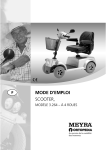
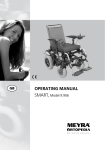
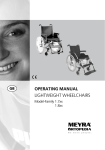
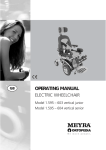
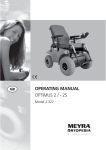
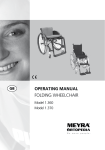
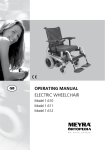
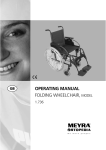
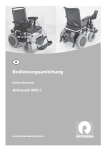
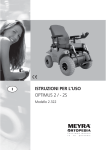
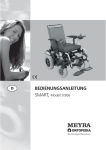
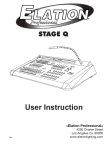
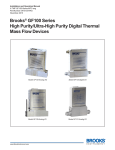
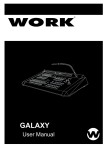


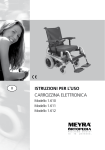
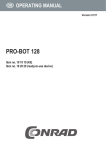
![e-track User`s Manual [FW1.00]](http://vs1.manualzilla.com/store/data/005696177_1-79f2a7130a6208690505d356432cfe5f-150x150.png)

